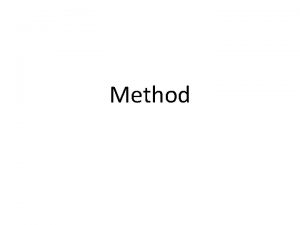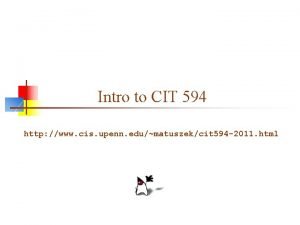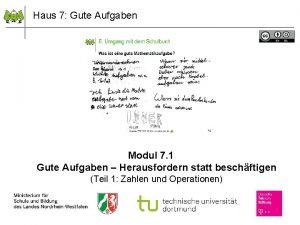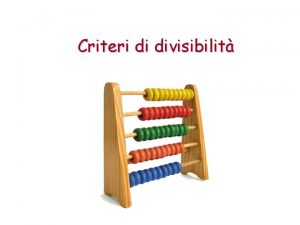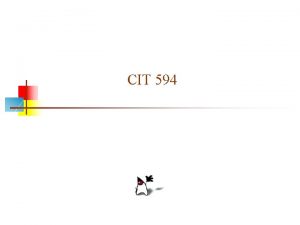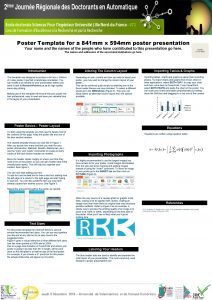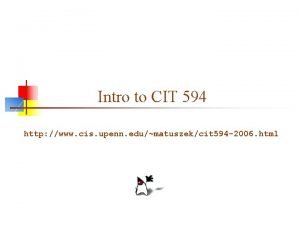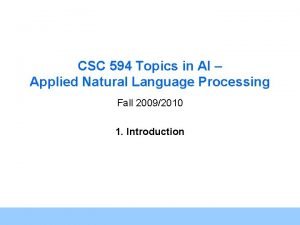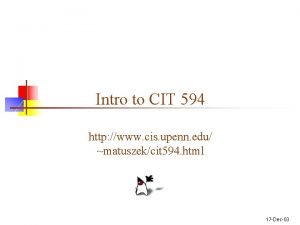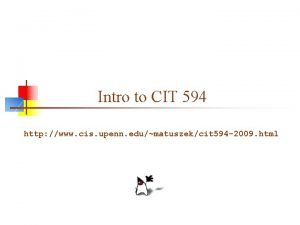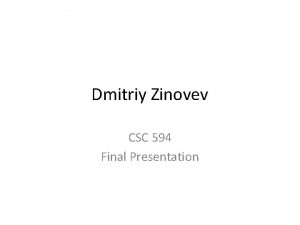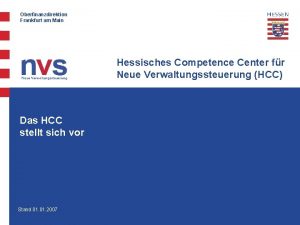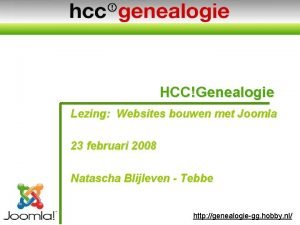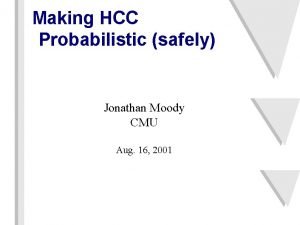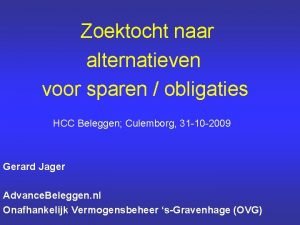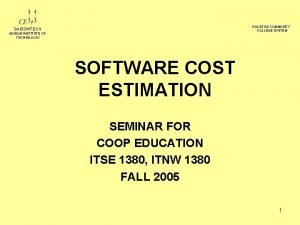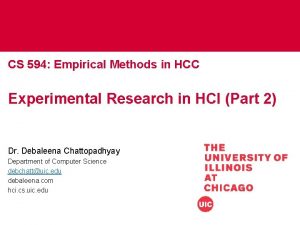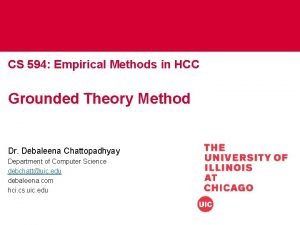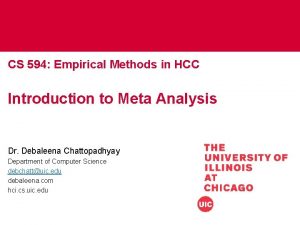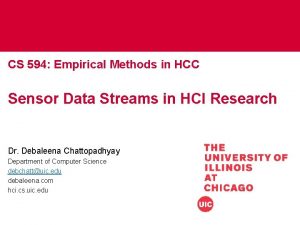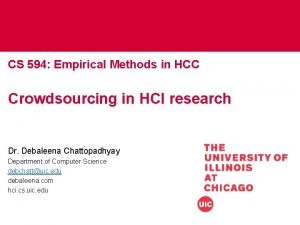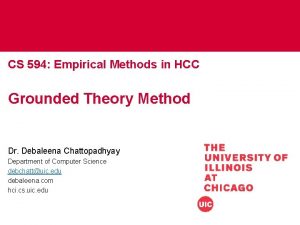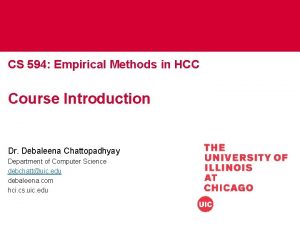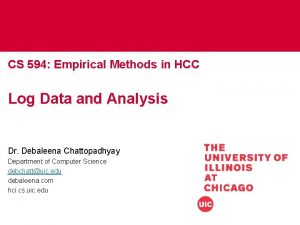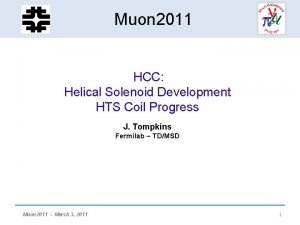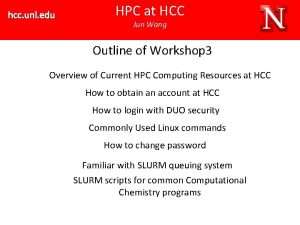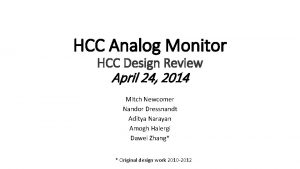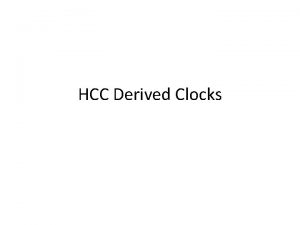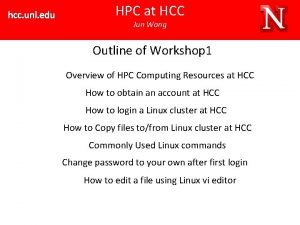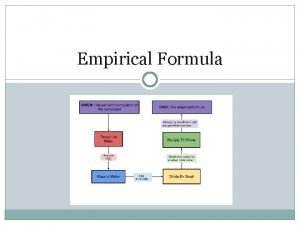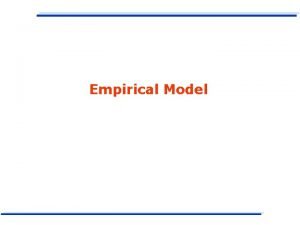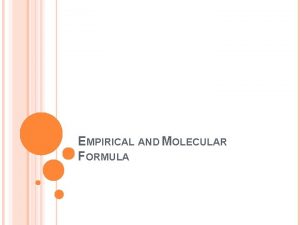CS 594 Empirical Methods in HCC Experimental Research



























- Slides: 27

CS 594: Empirical Methods in HCC Experimental Research in HCI (Part 1) Dr. Debaleena Chattopadhyay Department of Computer Science debchatt@uic. edu debaleena. com hci. cs. uic. edu

Agenda • • • Overview Sampling Significance Testing Study Design Parametric Statistics – – – Correlation Regression T-test ANOVA Multilevel Linear Modeling

Overview • Experimental research is used in HCI to answer questions of causality. • To show the manipulation of one variable of interest has a direct causal influence on another variable of interest • Exp. Research in HCI builds upon the tradition of psychology, sociology, cognitive science, information science, and broadly social science. • Exp. Research in HCI can be theoretically driven or engineering driven.

Advantages and Limitations of Exp. Research • Advantages – Internal validity – Demonstrate a strong causal connection – Provides a systematic process to test theoretical propositions and advance theory • Disadvantages – Requires well-defined, testable hypotheses, and a small set of wellcontrolled variables. – Risk of low external and ecological validity – A poorly executed experiment may have the veneer of “scientific validity” because of the methodological rigor, but ultimately provides little more than well-measured noise.

Sampling

Sampling (cont…. ) • Non-probability sampling – Snowball sampling – Quota sampling • Probability sampling – Random selection – To err is human, to randomly err is statistically divine.

Hypothesis Formulation • • Precise Meaningful Testable Falsifiable

Study Design • Independent and Dependent variable • Operational definition • Manipulation check and check for operational confounds • Reliability and Validity of the dependent variable – – – Rules for quantifying Scope and boundaries of what is to be measured Face validity, concurrent validity, predictive validity Use standardized measures whenever you can Consider sensitivity and practicality

Significance Testing • The first step in null hypothesis significance testing is to formulate the original research hypothesis as a null hypothesis and an alternative hypothesis. • The null hypothesis (H 0 ) is set up as a falsifiable statement that predicts no difference between experimental conditions. • The alternative hypothesis (often written as HA or H 1) captures departures from the null hypothesis.

Building a model out of data

Example model

Parametric data

Skewness and Kurtosis • • Positively skewed Negatively skewed Platykurtic Leptokurtic

Significance Testing (cont…) • Type 1 error = Pr(reject H 0 | H 0 true). (also significance level or alpha) • p value describes the probability of obtaining the observed data, or more extreme data, if the null hypothesis were true. Pr(observed data| H 0 true) • p <. 05 means the chances of a Type I error occurring are less than 5 %.

Type 1 and Type 2 error

Type 1 and Type 2 error (cont…)

Type 1 and Type 2 error (cont…)

Study Design (cont…) • • • Randomized Experiments Between Subject Experiments Within Subject Experiments Mixed or Factorial Designs How to balance to avoid order effect? – Complete counterbalancing; >= n! participants needed – Use Latin Square Designs or Balanced Latin Square Designs

Study Design (cont…)

One-tailed vs. Two-tailed • Assumption: DV follows a normal distribution

Latin Square Balancing

Quasi-Experimental Designs in HCI • Non-equivalent group designs – Pre-test/post-test design • Interrupted Time-Series Design – Infers the effects of an independent variable by comparing multiple measures obtained before and after an intervention takes place. – major threats to internal validity

Writing up Experimental Research • Answer “Why should anyone care? ” • Use APA conventions—mostly accepted • Results should contain the study design and statistical tests • Discussion should contain how the results address the HCI research question operationalized using the metrics and tested. • Report effect size. • Pre-register large experiments with OSF

Assumptions of parametric data • • Normally distributed data Homogeneity of variance Interval data Independence

Statistical Power and Effect Sizes • Effect sizes are useful because they provide an objective measure of the importance of an effect. • Effect size depends on: – Sample size – Alpha – Statistical power of the test used • The power of a test is the probability that a given test will find an effect assuming that one exists in the population. If β, the probability of a Type II error, power = 1 - β.

Parametric tests • • • Correlation Regression T-test ANOVA GLM

Upcoming: • Proposal due Sep 24, 11: 59 pm • Start working on your annotated bibliography
 Disadvantages of experimental research
Disadvantages of experimental research Research instrument in experimental research
Research instrument in experimental research Research instrument in experimental research
Research instrument in experimental research Experimental vs non experimental
Experimental vs non experimental Experimental vs non experimental
Experimental vs non experimental Non experimental design vs experimental
Non experimental design vs experimental Nonexperimental study
Nonexperimental study Cis 380 upenn
Cis 380 upenn Pikas mal plus haus
Pikas mal plus haus Tabella criteri di divisibilità
Tabella criteri di divisibilità Cit594
Cit594 841*594
841*594 Mcit 594
Mcit 594 Magni 575
Magni 575 Ai 594
Ai 594 Upenn cis courses
Upenn cis courses Introtocit
Introtocit Com(2020) 594 final
Com(2020) 594 final Oberfinanzdirektion frankfurt am m wiesbaden
Oberfinanzdirektion frankfurt am m wiesbaden Hcc genealogie
Hcc genealogie Slidetodoc.com
Slidetodoc.com Gebouwinspectie met drone
Gebouwinspectie met drone Hawkmail hcc
Hawkmail hcc Nunzia labarile
Nunzia labarile Interessante obligaties
Interessante obligaties Hcc survival rate
Hcc survival rate Saigon tech hcc
Saigon tech hcc Child pugh skoru
Child pugh skoru


